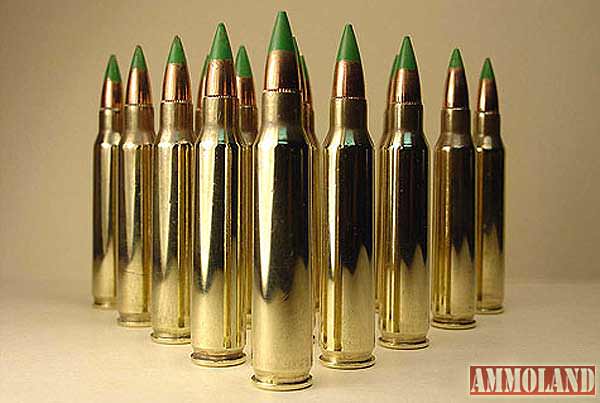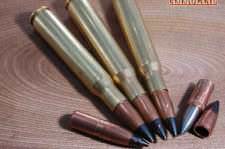

USA –-(Ammoland.com)- On February 13, 2015, the Bureau of Alcohol, Tobacco, Firearms and Explosives (ATF) released its proposed framework for determining whether a particular projectile may be exempted from the definition of “armor piercing ammunition.”
The complete text of the document, which we will refer to as simply “the framework,” can be accessed at ATF’s website at here.
I. Background
In 1986, the Congress amended the Gun Control Act by adding certain provisions to prohibit the manufacture and import of armor piercing ammunition, and prohibit licensed manufacturers and importers from selling or delivering armor piercing ammunition. See 18 U.S.C. §§ 922(a)(7) and (a)(8).
The only exceptions are for government agencies, exports, and for testing or experimentation authorized by the Attorney General.

The term “armor piercing ammunition” is defined, in pertinent part, as a projectile or projectile core which may be used in a handgun and which is constructed entirely from one or a combination of tungsten alloys, steel, iron, brass, bronze, beryllium copper or depleted uranium. The statute gives the Attorney General the authority to exempt from the definition any projectile which he finds is “primarily intended to be used for sporting purposes.” See 18 U.S.C. § 921(a)(17)(C). In 1986, ATF used this authority to exempt 5.56 mm (.223) SS109 and M855 “green tip” ammunition containing a steel core. In 1992 ATF used the sporting purposes exemption again for .30-06M2AP cartridges.
From 2011 to the present, ATF has received approximately 30 exemption requests for various ammunition containing steel or other specified metal cores. The reasons for the influx of exemption requests include pressure on the ammunition industry to produce alternatives to lead ammunition, as well as increased production of handguns designed to use conventional rifle ammunition. Even though the ammunition was originally produced for rifles, the fact the rounds can be used in a handgun brings the ammunition within the language of the statutory definition. Manufacturers of the ammunition have requested exemptions so they may lawfully manufacture and distribute the ammunition in commercial channels.
II. Summary of ATF’s Proposed Framework
The framework emphasizes the importance of interpreting the statute in a manner that carries out ATF’s goal of protecting law enforcement officers from death or injury from criminal use of handgun ammunition capable of penetrating soft body armor. Accordingly, ATF states it must determine that a specific projectile does not pose a significant threat to law enforcement officers because the projectile is “primarily intended” for use in shooting sports and is unlikely to be encountered by law enforcement officers on the streets.
In interpreting the “primarily intended” language, ATF believes the most relevant intent is that of a criminal who seeks to use armor piercing ammunition. ATF notes that the manufacturer’s intent that the ammunition be used for hunting or target shooting is irrelevant if it can potentially be diverted to criminals to defeat soft body armor worn by police officers. For this reason ATF rejects adopting an interpretation that allows the manufacturer’s intent to be dispositive, but that it is appropriate to consider the likely use of a particular type of ammunition in the general community, which leads to consideration of the types of handguns readily available to accept that ammunition.
In other words, the characteristics of the handguns in which a specific projectile may be used will determine that projectile’s likely use in the community.
The framework sets forth two categories of projectiles which would be eligible for exemption under the “primarily intended to be used for sporting purposes” language. Those projectiles are the following:
1. Category I: .22 Caliber Projectiles
A .22 caliber projectile that otherwise would be classified as armor piercing ammunition under 18 U.S.C. 921(a)(17)(B) will be considered to be “primarily intended to be used for sporting purposes” under section 921(a)(17)(C) if the projectile weighs 40 grains or less AND is loaded into a rimfire cartridge.
2. Category II: All Other Caliber Projectiles
Except as provided in Category I (.22 caliber rimfire), projectiles that otherwise would be classified as armor piercing ammunition will be presumed to be “primarily intended to be used for sporting purposes” under section 921(a)(17)(C) if the projectile is loaded into a cartridge for which the only handgun that is readily available in the ordinary channels of commercial trade is a single shot handgun. ATF retains the discretion to deny any application for a “sporting purposes” exemption if substantial evidence exists that the ammunition is not primarily intended for such purposes.
The term “single shot handgun” means a break-open or bolt action handgun that can accept only a single cartridge manually, and does not accept or use a magazine or other ammunition feeding device. The term does not include a pocket pistol or derringer-type firearm.
III. Impact of Framework – Previous Exemptions
It is important to note that in applying the sporting purposes categories set forth above, the 5.56mm projectile ATF exempted in 1986 will NOT qualify for an exemption because cartridges containing this projectile may be used in handguns that are not single-shot. These cartridges are commonly used in AR-type handguns that utilize magazines. Accordingly, for purposes of consistency, ATF states that it will withdraw the exemptions for the 5.56mm “green tip” ammunition, including both the SS109 and M85 cartridges.
The exemption for the 30-06 M2AP cartridges would continue because there are no multi-shot handguns that currently accept such ammunition.
A significant number of cartridges originally manufactured for rifles would NOT be eligible for the exemption under the criteria proposed in the framework. For example, .224 and .308 cartridges would NOT be exempted due to the availability in commercial channels of AR and AK-type pistols, clearly not single-shot firearms. Projectiles in .430 caliber would also NOT be exempted due to the availability of .44 magnum handguns which will chamber this ammunition. Finally, .458 bullets, very popular for big game hunting, would NOT be exempted due to the availability of multi-shot handguns in 45-70 caliber.
All of this ammunition would continue to be subject to the restrictions on manufacture, importation, and distribution of armor piercing ammunition.
IV. Public Comment
ATF is soliciting comments on the proposed framework from all interested parties. ATF specifically requests comments on how best to implement the withdrawal of the exemption for 5.56 mm ammunition to minimize disruption to the industry.
All comments must be received by ATF on or before March 16, 2015. Comments may be submitted through ATF’s website at APAComments@atf.gov. Comments may also be faxed to (202)648-9741 or mailed to the following address:
Denise Brown
Mailstop 6N-02
Office of Regulatory Affairs
Enforcement Programs and Services
ATF
99 New York Avenue, NE
Washington, DC 20226
ATTN: AP Ammo Comments
Industry members and others who will be affected by the proposals are strongly encouraged to submit meaningful comments to ATF by the closing date. Comments with alternative interpretations of the exemption language would be particularly helpful.
The above analysis is for informational purposes only and is not intended to be construed or used as legal advice. Receipt of this alert does not establish, in and of itself, an attorney-client relationship.
Questions about this alert can be directed to:
- Johanna Reeves: 202.715.9941 | jreeves@reevesdola.com
- Teresa Ficaretta: 202.715.9183 | tficaretta@reevesdola.com
About Reeves & Dola
Reeves & Dola is a Washington, DC law firm that specializes in helping clients navigate the highly regulated and complex world of manufacturing, sales and international trade of defense and commercial products. We have a deep understanding of the Federal regulatory process, and use our expertise in working with a variety of Federal agencies to assist our clients with their transactional and regulatory needs. www.reevesdola.com
